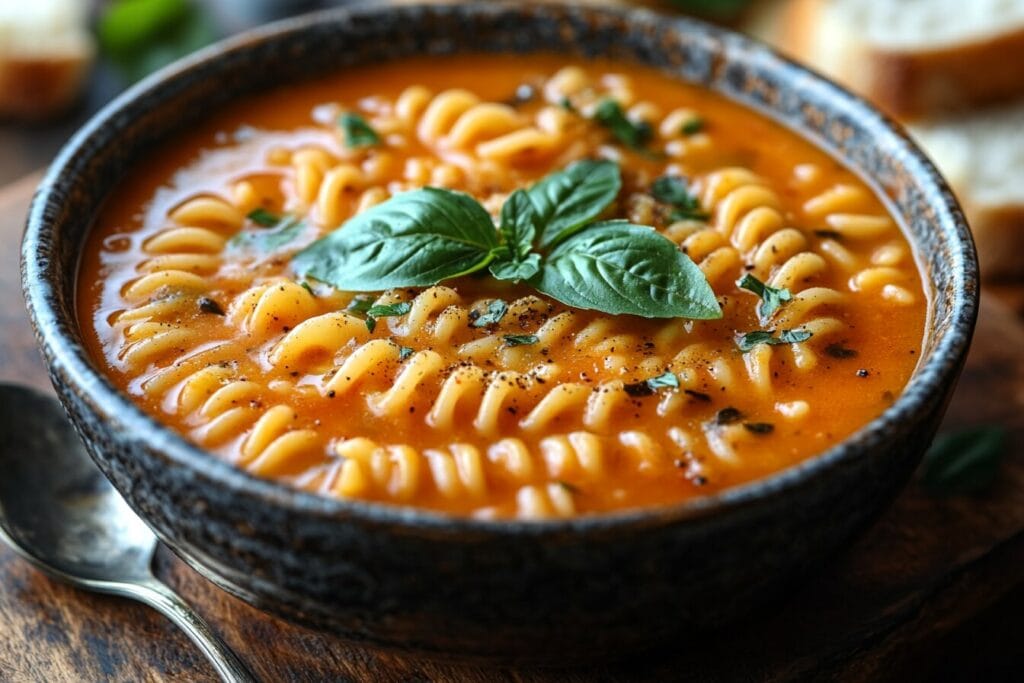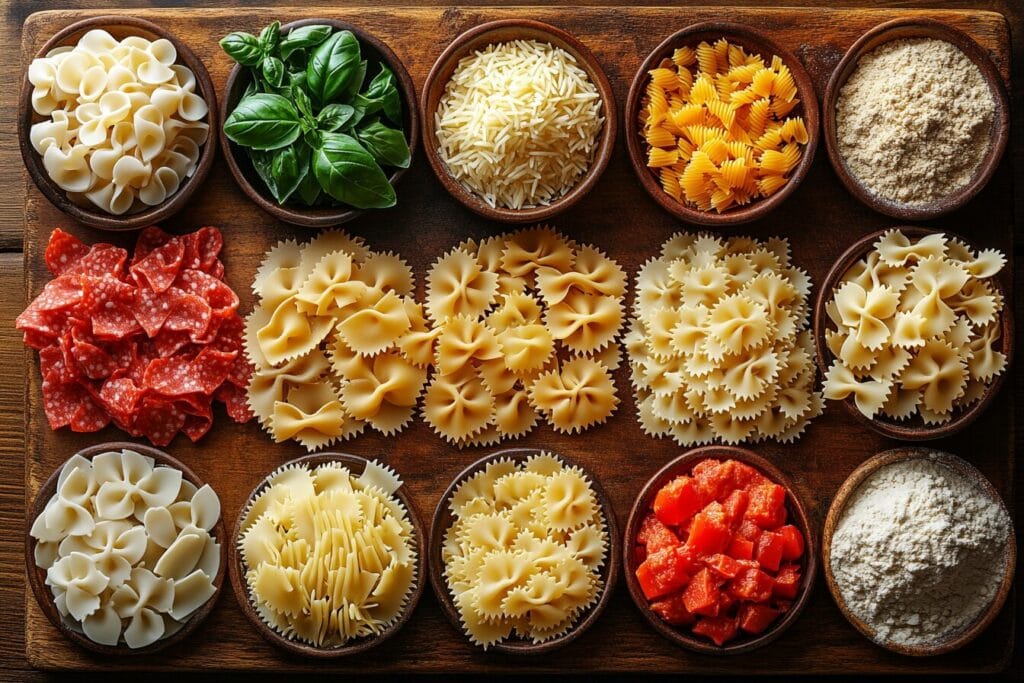Ever found yourself wondering, “What pasta is best for soup?” Don’t worry—you’re not alone! The world of pasta is vast, and picking the right one for your soup can feel like trying to solve a delicious puzzle. But don’t fret! This guide is here to make it all clear and fun for you. From tiny orzo to twirly fusilli, we’ll explore the ins and outs of pasta in soups and solve common kitchen challenges along the way.
Introduction
Pasta and soup—two of the ultimate comfort foods. When combined, they create pure magic! But not all pasta is created equal when it comes to soups. Some shapes soak up broth like a sponge, while others hold their own against hearty ingredients like meat and vegetables.
In this guide, we’ll dive into how pasta type can transform your soup into a bowl of perfection. Whether you’re a beginner or a soup master, by the end, you’ll know exactly what to pick for your next creation.

Why Does Pasta Matter in Soups?
You might be thinking, “Does it really matter what pasta I toss into my soup?” The answer is a resounding YES! Here’s why:
The Role of Texture and Flavor
Pasta isn’t just there to fill you up. It brings texture and flavor to the table. Imagine sipping on a chicken noodle soup where the pasta is soft and silky, complementing the delicate broth. Now, imagine the same soup with overcooked mushy pasta… Not so appetizing, right?
Choosing the right pasta means you’re balancing the soup’s overall mouthfeel. It’s like picking the perfect dance partner for a waltz—they have to match the rhythm.
How Pasta Shapes Affect Cooking
Pasta comes in all shapes and sizes for a reason. Tiny stars like pastina are great for light broths, while sturdier shapes like penne can handle heavier, chunky soups. Each shape interacts differently with the broth and ingredients, making the selection crucial. It’s like choosing the right tool for the job—don’t use a hammer when you need a screwdriver!
Types of Soups and Their Ideal Pasta
Let’s pair soups with their pasta soulmates!
Clear Soups: Perfect Pasta Choices
For light and clear soups like consommé or chicken broth, go for small pasta shapes. Think orzo, pastina, or stelline (little stars). These tiny pieces don’t overpower the broth but add just enough texture to keep things interesting.
Pro Tip: Always cook small pasta al dente (slightly firm) to prevent it from turning into a soggy mess when reheated.
Creamy Soups: Balancing Pasta with Richness
Creamy soups, like a velvety tomato bisque, need pasta that won’t soak up too much liquid. Shapes like rotini or farfalle (bowties) work wonders because their nooks and crannies catch just enough of the creamy goodness.
Hearty Soups: Choosing Sturdy Pasta
When it comes to chunky, hearty soups like minestrone or beef stew, go bold. Use penne, rigatoni, or even cavatappi (corkscrews). These shapes can handle the weight of veggies, beans, and meats without breaking down.
Popular Pasta Options for Soups
Let’s explore the pasta aisle and pick the stars of your soup.
Small Pasta Shapes: Ditalini, Orzo, and Pastina
These tiny shapes are perfect for delicate soups. Ditalini (short tubes) are classic in Italian wedding soup. Orzo resembles rice and is a favorite for Greek-style soups. Pastina, the tiniest of all, is comfort food at its best. Think of these as the MVPs for kids’ soups too.
Medium-Sized Pasta: Farfalle, Fusilli, and Rotini
Medium pasta brings versatility. Their shapes add a fun twist (literally!) to creamy or cheesy soups. If you’re whipping up a mac-and-cheese-style soup, these are your go-to guys.
Long Pasta: Spaghetti, Fettuccine, and Linguine
Long pasta in soup? Yes, please! Think ramen bowls or chicken noodle soup with long, slurpable strands. Break them into smaller pieces to avoid the “Lady and the Tramp” moment at the dinner table.

Common Problems When Using Pasta in Soups
Nobody’s perfect, and pasta isn’t either. Let’s tackle some common issues.
Overcooked Pasta: How to Avoid It
One minute, your pasta is perfect. The next, it’s mush. Overcooking happens fast, especially if the pasta sits in hot broth for too long. The fix? Cook it separately and add it to the soup just before serving.
“Cook pasta separately if you’re meal-prepping soups. This keeps the texture spot-on!”
Undercooked Pasta: What to Do
On the flip side, undercooked pasta can feel like chewing on rubber bands. If you’ve undercooked it, just simmer the soup for a few more minutes. No harm done!
Soggy Pasta in Leftover Soups
Leftovers are great, but pasta in leftover soup? Not so much. The pasta keeps absorbing liquid, turning it into a soggy mess. Solve this by storing the pasta separately and combining it when reheating. Easy peasy!
Tips for Cooking Pasta Perfectly for Soups
Let’s master pasta cooking with these quick tips.
Cooking Pasta Separately vs. In-Soup
Cooking pasta separately might feel like extra work, but it’s worth it. It gives you control over texture and prevents the soup from turning into a starch bomb. Plus, you can store leftovers without worrying about sogginess.
Measuring the Right Pasta-to-Soup Ratio
Too much pasta can turn your soup into a casserole. Use about ½ cup of pasta for every 4 cups of soup to maintain balance.
Timing Pasta Addition in Soup Recipes
If you’re cooking pasta in the soup, add it during the last 8–10 minutes of cooking. This ensures it cooks just right without overstepping its welcome.
Nutrition Facts: How Pasta Impacts Your Soup
Here’s a quick look at how pasta contributes to the nutritional profile of your soup:
| Nutrient | 1 Cup Cooked Pasta |
|---|---|
| Calories | ~200 |
| Carbs | ~40g |
| Protein | ~7g |
| Fiber | ~2g |
| Fat | ~1g |
Note: Values vary based on pasta type.
Gluten-Free and Alternative Pastas for Soups
Let’s talk about pasta options beyond the traditional wheat-based varieties. Whether you’re gluten-sensitive, exploring healthier options, or just curious, there’s a whole new world of pasta out there waiting to dive into your soups!
Rice-Based Pastas: Pros and Cons
Rice-based pastas, like rice noodles or gluten-free spaghetti, are fantastic for clear broths or Asian-inspired soups. They’re light, delicate, and naturally gluten-free. However, they can get sticky if overcooked. Pro tip? Cook them separately and rinse with cold water to avoid clumping.
Quote: “Rice-based pasta is perfect for light soups, but timing is everything—cook it too long, and it turns gummy!”
Legume and Lentil Pastas: Nutritious Options
For a protein-packed option, try lentil or chickpea pasta. These are sturdy enough for heartier soups and bring a mild, earthy flavor to the dish.Plus, they’re loaded with fiber and keep you full longer. Just keep an eye on the cooking time—they cook quicker than wheat pasta.
Storing and Reheating Soups with Pasta
Leftovers? Yes, please! But reheating soup with pasta can be tricky. Let’s ensure every bowl tastes as good as the first.
Best Practices for Keeping Pasta Fresh in Soups
The golden rule? Store pasta and soup separately. This prevents the pasta from soaking up all the liquid and turning soggy. If that’s not possible, undercook the pasta slightly before storing the soup. The pasta will soften to the perfect texture when reheated.
Reheating Tips to Maintain Texture
Reheating is an art. Use a gentle simmer to warm your soup and add a splash of broth or water to maintain the consistency. If you stored the pasta separately, toss it into the soup during the last few minutes of reheating for a fresh taste.
Quote: “The secret to reheating soup with pasta? A splash of extra broth and low, slow heat.”
Regional and Cultural Influences on Pasta in Soups
Pasta isn’t just a universal comfort food—it’s also a window into different cultures and traditions. Let’s explore how regions around the world embrace pasta in their soups.
Italian Minestrone: Traditional Pasta Choices
Italy, the birthplace of pasta, has given us classics like minestrone. This chunky vegetable soup often features ditalini or tubetti, tiny tube-shaped pastas that hold up well to hearty ingredients. 🇮🇹
Asian Soups: Integrating Pasta with Brot
While not technically pasta, Asian rice noodles and egg noodles play a similar role in brothy soups like pho and ramen. They’re slurpable, flavorful, and soak up the rich spices in the broth.
FAQ: What Pasta is Best for Soup?
Should I cook pasta separately before adding it to soup?
Yes, especially if you plan to store leftovers. Cooking pasta separately prevents it from overcooking or absorbing too much broth. Add it to the soup just before serving to maintain the perfect texture.
What’s the best gluten-free pasta for soups?
Rice-based or legume-based pastas are excellent gluten-free options. Rice noodles work well for light broths, while chickpea or lentil pastas are sturdy enough for heartier soups.
Can I freeze soups with pasta?
You can, but it’s not ideal. Pasta tends to become mushy when frozen and reheated. For best results, freeze the soup without the pasta and cook fresh pasta when you’re ready to serve.
What’s the healthiest pasta for soup?
Whole wheat, legume-based, or gluten-free pastas like chickpea or lentil varieties are nutrient-dense and higher in fiber and protein compared to regular white pasta.
Is it okay to break long pasta for soup?
Yes! Breaking spaghetti or other long pasta into smaller pieces makes it easier to eat and more manageable in soups like chicken noodle soup or minestrone.
What’s the difference between adding pasta directly to soup versus cooking it separately?
Adding pasta directly to soup lets it absorb the broth’s flavors but risks overcooking and making the soup starchy. Cooking pasta separately ensures it stays firm and the broth remains clear.
Which pasta works best for creamy soups?
Medium-sized pastas like farfalle (bowties) or fusilli are great for creamy soups. Their shape holds onto the creamy sauce, giving each bite maximum flavor.
Conclusion: Finding Your Perfect Pasta for Soups
So, what pasta is best for soup? The answer depends on your soup type, cooking method, and personal taste. Whether it’s tiny orzo in a chicken broth or hearty rigatoni in a minestrone, the right pasta can elevate your soup from good to unforgettable. Remember, the secret is in the balance—choose wisely, and every bowl will feel like a warm hug.
Bonus: Quick Pasta Soup Recipe for Inspiration
Here’s a quick and easy soup recipe to put your pasta knowledge into action.
Classic Chicken Noodle Soup
| Ingredient | Quantity |
|---|---|
| Chicken broth | 6 cups |
| Cooked chicken (shredded) | 2 cups |
| Ditalini pasta | 1 cup |
| Carrots (sliced) | 2 medium |
| Celery (sliced) | 2 stalks |
| Onion (diced) | 1 small |
| Garlic (minced) | 2 cloves |
| Olive oil | 1 tbsp |
| Salt and pepper | To taste |
Instructions:
- Heat olive oil in a pot. Sauté onion, garlic, carrots, and celery until tender.
- Add chicken broth and bring to a boil.
- Stir in ditalini pasta and cook until al dente.
- Add shredded chicken, season with salt and pepper, and simmer for 5 minutes.
- Serve hot and enjoy!

